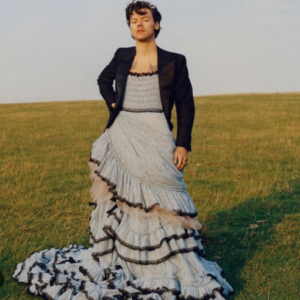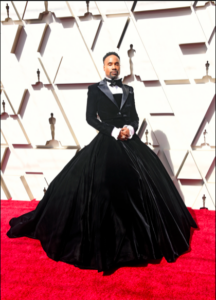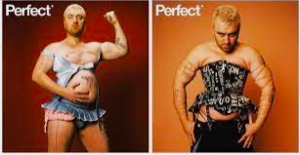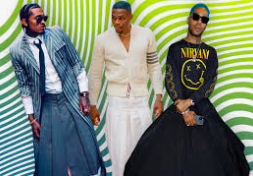
Since 1892, the renowned American fashion magazine,Vogue, has done several publications that have excited the world of fashion. In its 127 years of publications, singer-songwriter Harry Styles made history in the December 2020 edition when he became the first male to appear by himself on the cover, and did so wearing a blue custom-made Gucci dress, adorned with ruffles and covered in black valenciennes lace and ribbons. Although this received lots of praise from critics, this also sparked a wave of controversy. For years, men have been wearing dresses and skirts including Freddie Mercury, Billy Porter, Marsha P. Johnson, Sam Smith, Vin Diesel, Jared Leto, and Marc Jacobs, in which they have broken the stigmas of what it means to be a man. Many of these critics say that men should not wear items such as dresses and skirts as it is ‘feminine.’ However, women have been wearing ‘masculine’ clothing such as trousers since the mid-twentieth century. The question now is, should men be allowed to wear ‘feminine’ clothing just as women can wear ‘masculine’ clothing?’ The answer is really another question, why do we need gendered clothing?
A History of Men’s Fashion
During the 14th century, fashion for both men and women wore similar in the articles of clothing. During this time, clothing was unflattering to the shape of one’s body and often included wearing an over-gown, tunic, and a kirtle that usually covered the whole body. It wasn’t until the rise of Gothic and Medieval fashion-the late 14th and 15th century- that the fashion between men and women changed. Women would wear kirtles and surcotes (over-dress) and men would wear a chemise, cotehardie, and hose (leggings for men). With evolving times, came evolving fashion that would later become more elaborate clothing for the upper classes. Within the next couple centuries, we see a change in the upper class fashion, thus the birth of fashion trends. These fashion trends connected political and societal rules and became what the majority of the world would look upon for inspiration.
The stigmatization of gendered clothing and the general consensus of ‘toxic masculinity’ did not really begin until the 19th century. With western society globalizing the world as it is known, western fashion defined for the world what a man and a woman should wear, imprinting the world of fashion as we know it.
Toxic Masculinity and its Stigmatization
Toxic masculinity can be defined as ‘the need to aggressively compete and dominate others and encompass the most problematic tendencies in men. These same male tendencies foster resistance to psychotherapy- a treatment that aims to help a person identify and change troubling emotions, thoughts, and behaviors.’ To identify toxic behaviors, some characteristics include unconditional physical toughness, physical aggression, fear of emotions, discrimination against people that aren’t heterosexual, hyper independence, sexual aggression or violence, and anti-feminist behavior, something of which has emerged into men’s clothing.
Today, the fashion industry is known to break gender stereotypes and move beyond toxic masculinity. Fashion designers have curated collections that both men and women breaking the stigmas of gendered clothing, showing that anyone can wear whatever they desire and still look and feel amazing in. However, this has created a conversation centered around the breaking of these stereotypes and asking the question, should men wear skirts and dresses and does it infringe on the true meaning of what it means to be a man? The idea of men in any clothing that is not deemed by society as masculine has received backlash from conservatives stating that dresses and skirts are ‘inherently feminine.’

Interestingly, with this whole argument about the acceptability of men wearing skirts or dresses, the individuals receiving the majority of the backlash are men of color and/or are a part of the LGBTQ+ community. In recent years, we have seen this portrayed on social media and on the red carpets. Actors like Billy Porter have received criticism for his outfit choices. In an interview with TODAY, Billy Porter shared his insight on gender-fluid or non-binary fashion and how it differentiates from being a black person and a white person. “I feel like the fashion industry has accepted me because they have to,” Porter said. “I’m not necessarily convinced and here is why. I created the conversation and yet Vogue still put Harry Styles, a straight white man, in a dress on their cover for the first time; I’m not dragging Harry Styles, but he is the one you’re going to try and use to represent this new conversation? He doesn’t care, he’s just doing it because it’s the thing to do. This is politics for me. This is my life. I had to fight my entire life to get to the place where I could wear a dress to the Oscars and not be gunned now. All he has to do is be white and straight.”
Whilst this tragically abrupts the wellbeing of all who have been afflicted with this ideology, it proves even more so for those of queer or colored identification. Individuals such as singer-songwriter Sam Smith have received scrutiny for their outfit choices because they do not fit into the societal standard of what it means to be a man. A recent example would be when he was featured on PERFECT Magazine. Wearing a corset in one image and an ultra mini skirt in the following picture, he received harsh criticism on Twitter from several conservatives, stating “Disgusting is a better description,” “What the hell is the given value of “perfect?,” “I understand why Hollywood would be obsessed with Harry Styles doing this type of thing because at least he has the charisma to make it work but I truly can’t wrap my head around their sudden hype of this dude who looks like the guy who comes to your house to pump the septic tank.1”

Although conservatives have done perceptively well in displaying an “equal” sense of critique toward the involved, conflicting political ideologies, further review of related media reports suggest a sense of acceptance for those who identify as straight, white, males and wear feminine clothing and an inverse sociological reaction for anybody else. As a society, we have collectively decided when it is ok to wear a skirt or dress, and have been shown that when it is someone who does not necessarily identify themselves as a black person or a part of the LGBTQ+ community, they fall under more scrutiny for being able to identify more with what is inherently feminine clothing. When this happens, we also fall under the toxic masculinity trope. Thankfully, with changing societal views, younger generations such as Gen Z have pushed for a change in which individuals have begun wearing whatever allows them to express their individuality.
Gender-Fluid, Gender-Inclusive, and Individuality
Fashion can have so many different outlooks depending on who is asking. In general, fashion makes a statement about the individual and how they portray themselves. In recent years, society has seen the rise of gender-fluid clothing, especially within the new generation of consumers, Gen Z.
Gender-fluid or gender-inclusive clothing has no agreed-upon definition within the fashion industry. The general consensus of what gender-fluid or gender-inclusive clothing is that our individual clothing is not limited to the traditional “menswear” and/or “womenswear” binary. Gender-fluid is clothing designed to liberate people from the binary standards of cis-women and cis-men. Unisex, gender-neutral and androgynous clothing are designed to push us to a future where gender within fashion doesn’t exist. Furthermore, some experts in the world of fashion have said that ‘gender-fluid clothing has little, if anything, to do with the brands, designers and retailers that create them. Instead, they argue that any piece of apparel can be gender-fluid if its wearer chooses.2’
Furthermore, according to Nick Paget, a senior analyst at the World Global Style Network (WGSN) suggests, “Gender-fluid clothing can be any clothing in theory; The notion that clothing as an expression of our personality belongs to one gender or another is the social construct that needs disassembling.” Within the past decade, brands have increasingly produced gender-fluid collections to meet consumer demand. In 2019, 56% of Gen Z consumers shopped what would be considered ‘outside their assigned gendered area’ says Rob Smith, the founder of the Phluid Project, a gender free fashion brand.3’
All things considered, fashion creates a statement and it’s not about gender. Clothing should not be gendered just because society has coveted it as such, even if it’s a political motivation, done because society deems it is ok to wear, or because we as a society just have to accept it. Fashion is a part of one’s identity and we as individuals should feel free to express ourselves in whatever article of clothing we wear, even if it is a custom-made blue Gucci dress on the cover of Vogue.
- “Sam Smith Wears Corsets, Receives Harsh Criticisms on Twitter.” Mix 99.5 WJBR. Accessed March 29, 2023. https://wjbr.com/listicle/sam-smith-wears-corsets-receives-harsh-criticisms/. ↵
- What Is Gender-Fluid Clothing? Fashion Industry Experts Explain.” NBCNews.com. NBCUniversal News Group, June 29, 2021. https://www.nbcnews.com/select/shopping/gender-fluid-clothing-ncna1270831?bestsellers=true. ↵
- What Is Gender-Fluid Clothing? Fashion Industry Experts Explain.” NBCNews.com. NBCUniversal News Group, June 29, 2021. https://www.nbcnews.com/select/shopping/gender-fluid-clothing-ncna1270831?bestsellers=true. ↵




22 comments
Fernando Milian
This is an interesting article that touches on a super debatable topic. The issue of fashion as an expression of sexuality and gender identity is one of those topics we could discuss for hours and hours and still not be done because the topic has much to say about it. Your article puts into perspective critical issues with which we have to deal today in this sense. I am in favor of inclusive clothing that shows no gender, but I do not think many people are. Some people like their blue and pink traditional clothes, and that is also respectable. We must all coexist with each other showing due respect to the people around us. Great article, and congrats on your well-deserved nomination.
Illeana Molina
Congratulations on the publication and nomination. I do love the blend of speaking on the fashion industry and how it can be incredibly toxic yet in the right way bring individuals together. Including the LBTQ+ community is huge and I support 100 percent. I am happy to see more diverse topics included in all pieces/infographics. I like your message and research. Great Job
Zachary Kobs
As I read the article, I learned about the history of men’s fashion and the recent controversy surrounding gendered clothing. It was interesting to see how fashion evolved over time and how men and women wore similar clothing during the 14th century. However, as the article pointed out, toxic masculinity has stigmatized men wearing feminine clothing. It is vital to move beyond traditional gender roles and norms and allow individuals to wear whatever they desire, fostering a society that embraces diversity in all its forms, including in fashion. Congratulations on your Nomination!
Aaron Astudillo
Congratulations on the publication and nomination Ana Lucia! I am very proud of you, this is an excellently crafted paper and shines a light on the LGBTQ+ community. I appreciate the research you have done into this and would once again like to commemorate you on your progress.
Anapatricia Macias Angulo
Hi Ana Lucia! I greatly enjoyed reading this article. You included a lot of important topics which people might not often think about when it comes to men wearing clothing deemed “feminine.” I appreciate how you included the issue of those in the LGBTQ+ community and men of color receiving the most backlash for wearing what they feel best in. I remember seeing Harry Styles’ Vogue cover and thinking that there have been many other men, specifically men of color, who have gone out and worn dresses or skirts. I applaud Harry Styles for his cover, but it is also important to recognize the issues men in these communities face when they have previously done the same thing. Amazing job!
Peter Alva
Although I enjoyed this article and enjoy men making fashion statements like hairy styles. Although wasn’t on Vouge, Young Thug (Atlanta Rapper) was one of the first to do something like this and paved the way for people like Harry Styles to be open to doing something like that. Granted both are apart of 2 different audiences but Young Thug wearing that dress is what I remember breaking the scene for men in fashion when it comes to wearing a dress.
Alanna Hernandez
I think many of the conception, that a man in the dress means a drag queen and therefore is gay which is a no no. When in fact it’s just clothes, no different then socks or a shirt. I’m glad to see that men are now more open to other men wearing what they want and actually having an outlet.I think a great example that could’ve been added is a young thug!
Isabel Soto
I want to congrats on getting your article nominated. This is a great article because more and more people who are afraid of being judged can not be ashamed of wanting to be themselves and live on. this article was well-written and very informative on things I didn’t know before reading this article. I agree with what you said here and that women clothes or man clothes are not a thing that should be title as one gender.
Isabella Lopez
I loved your article. My favorite thing about fashion is that it’s our form of expression. My work environment is a place with a lot of self expression which has inspired me to be more genderfluid with clothing but I feel it makes me feel more connected to my identity and sexuality.
Melanie Fraire
I really enjoyed this article and the topic chosen for it. I find it very upsetting that people focus so much on clothes having a gender rather than just letting others wear what they want and accepting it but I do hope that society moves past this in the future.